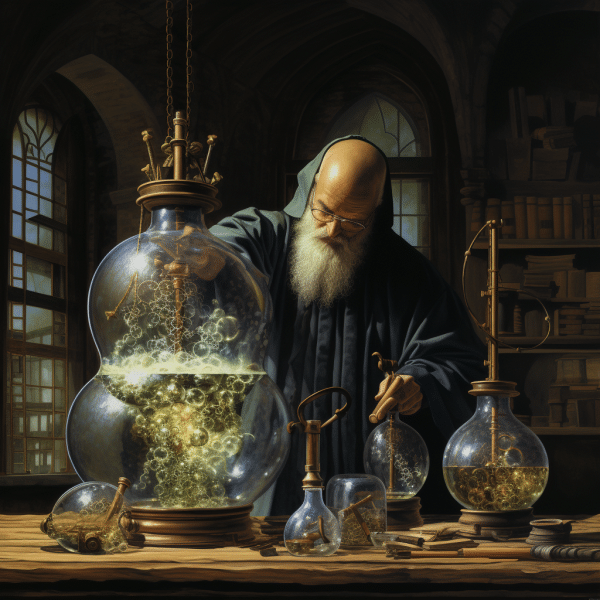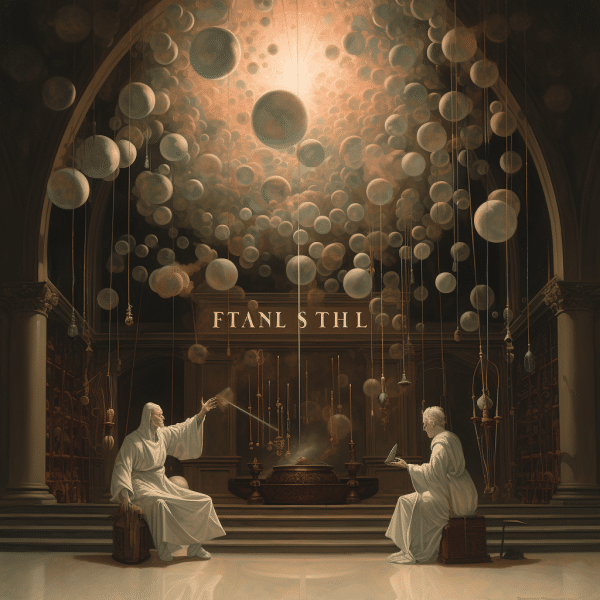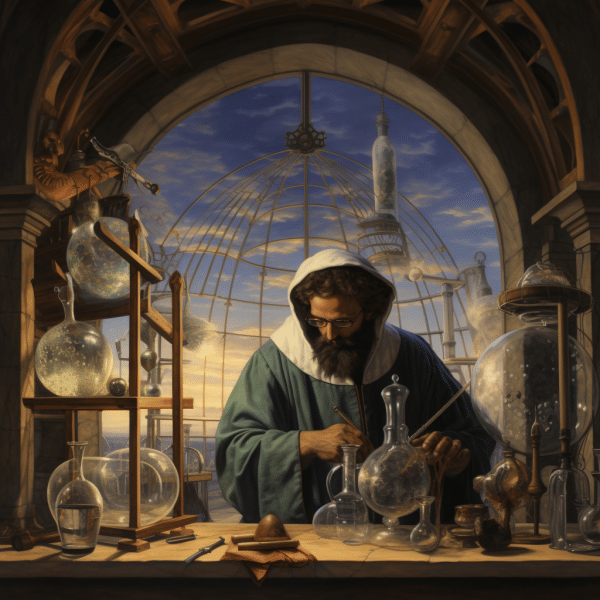

Although they’re different, faith and science have points in common. They both try to answer questions about life and give us ways to make sense of things. Faith usually deals with spirituality and morals, while science looks at why things happen.
A good example of faith and science meeting is the case of Galileo Galileo. In the 17th century, he said that the Earth goes around the sun – which went against religious teaching. This caused a lot of opposition to him.
Clashes like this happen when faith and science disagree. But it’s not the faith or science that causes the problems – it’s how people interpret them.
In conclusion, faith and science are two sides of the same coin. Rather than seeing them as enemies, it’s better to look at how they combine. By doing this, we can have a better understanding of the universe and our place in it.
Definition of faith
Faith is an essential concept in humanity. It’s the base of many cultures’ belief systems. It’s a strong confidence in something or someone, without evidence. Faith is different from science, which uses data and reason to discover facts. Deals with matters beyond logic.
Faith offers solace and meaning in life. It helps people in hard times, as a source of hope and resilience. Even though science explains things, it can’t bring comfort to the soul.
The difference between faith and science is their way of understanding reality. Science seeks definite answers by studying the physical world. On the other hand, faith embraces the unknown.
It’s important to recognize that both faith and science are good. Faith brings spiritual fulfillment and science brings technology, medicine, etc. To have a full understanding of life, we must find a balance between them. Here are some tips:
- Be open-minded. Look at scientific discoveries with curiosity and see the magic of faith.
- Find harmony. Don’t view faith and science as rivals, let them help each other.
- Talk. Have conversations with people who may hold different views and listen to each other.
By understanding faith and science, we can have a better view of the world. We can find peace in religious practices and answers in scientific exploration. A combination of these gives us a full appreciation of our world.
Definition of science
Science is the study of the natural world through observation and testing. Data is collected, theories proposed, experiments done, and conclusions made based on evidence. It is an evolving field with new info and discoveries. It relies on empirical evidence and follows a methodical process for objectivity and accuracy.
Scientific knowledge is built on existing theories and principles which are always being tested and improved. Through research, scientists try to understand the universe and explore what causes certain phenomena. Plus, science often leads to new tech, medical advances, and an understanding of our place in the world.
One thing that sets science apart is its focus on logical thinking and critical analysis. Scientists use repeatable experiments to ensure their findings are reliable. This is different from other ways of knowing like faith or personal beliefs.
However, science has limitations. It can’t answer all questions or address matters related to morality, aesthetics, or subjective human experiences. Acknowledging these limits helps us understand how science relates to other kinds of knowledge.
In terms of science and faith, they can be seen as complementary. Science can answer questions about the natural world while faith focuses on philosophical and existential questions. Both offer unique perspectives that add to our understanding of life.
Dialogue between scientists and theologians is a great way to bridge the gap between scientific inquiry and religious beliefs. Respectful conversations allow for exploration of common ground and appreciation of diverse perspectives. Plus, it allows individuals to navigate science and faith in a more harmonious way.
Differences between faith and science
To understand the differences between faith and science, delve into the contrasting perspectives they offer. Explore the dichotomy of belief vs. evidence-based approaches, subjectivity vs. objectivity, faith in the unseen vs. observation and experimentation, and the role of emotion vs. logic and reason. Gain insights into these intriguing dynamics.
Belief vs. evidence-based
Belief and evidence-based approaches are distinct. Comparison reveals contrasts: belief is rooted in faith/trust whereas evidence-based is grounded in data. Belief is subjective, whereas evidence-based is objective. Validation of belief is personal conviction, whereas evidence-based is scientific method. Reliability of belief varies, whereas evidence-based is consistent and replicable.
Despite differences, both fulfill important roles. Belief allows expression and spiritual fulfillment. Evidence-based ensures accuracy and reliability.
Belief extends beyond religious contexts. It shapes values, traditions, and hypotheses not yet proven. Anna’s story is a good example. Initially she was skeptical ’cause of beliefs. But she engaged with studies/experts and revised her perspective. Now she combines belief and evidence in advocating for climate action.
Subjectivity vs. objectivity
Subjectivity and objectivity are key to understanding the gap between faith and science. Subjective perspectives are based on feelings and beliefs. In contrast, objective perspectives depend on verifiable evidence and unbiased analysis.
Let us explore this contrast:
Subjectivity:
- Influenced by personal feelings
- Biased interpretation
- Relies on personal opinions
- Varies with beliefs
Objectivity:
- Based on verifiable evidence
- Impartial observation
- Utilizes empirical data & logical reasoning
- Consistent, universally applicable principles
Subjectivity has worth in comprehending individual experiences. But for scientific research and general conclusions, objectivity is the main methodology.
Faith often originates from beliefs or spiritual experiences. Science focuses on empirical evidence and rational inquiry.
Albert Einstein said, “Science without religion is lousy, religion without science is blind.
” This highlights the importance of bringing faith and science together, despite their differences.
Faith in the unseen vs. observation and experimentation
Believing in what we can’t see, without proof, is completely different from observation and experimentation – the base of scientific research. Faith needs trust and personal belief while science needs evidence and reproducible outcomes. It’s due to a difference in purpose: faith searches for spiritual truths outside the physical world, but science strives to understand and explain natural phenomena with studies.
Observation and testing are the basis of scientific progress. Scientists watch and record data from experiments, then analyze it to reach conclusions. Science makes sure it’s objective with regular testing. As new evidence appears, science moves forward and can get to know our universe better.
On the other hand, faith in the unseen is part of many spiritual beliefs. It requires faith in teachings and ideas that are beyond physical proof. Faith helps people find themselves and explore issues like spirituality, morality and meaning. Unlike science’s focus on results and quantities, faith looks at subjective experiences and questions.
Science offers explanations based on evidence but faith looks at things that we can’t measure or observe. It gives comfort in times of fear and hope in moments of despair. We can have both because they have different scopes: science investigates physical things we can see, and faith looks at those we can’t.
Religion and science are both important for many people. Appreciating the difference can allow us to accept diverse views without lessening the importance of either. Remembering that faith and science work together creates a fuller understanding of our world – a balance between seen and unseen.
Role of emotion vs. logic and reason
The clash between emotion and logic in the realm of faith and science is often debated. It’s a battle between heart and mind – two strong forces that mold our views and knowledge of the universe.
Emotion, with its passionate intensity and vulnerability, impacts our outlooks. It’s through emotion that we attach to our trust or faith system more profoundly. Emotion grants us a feeling of amazement, wonder, and connection to something bigger than ourselves. It gives us peace in times of unease and gives us expectation in the face of hardship.
On the other hand, logic and reason are just as essential to our analysis of the world. They allow us to inspect proof, make sensible choices, and come to decisions based on factual data. Logic encourages critical thinking and doubtfulness – vital for scientific exploration.
Although emotion may lead us away from the truth and logic might hinder our capacity to appreciate the loveliness of faith, it’s vital to maintain a balance between the two. Emotion shouldn’t entirely replace logic, just as logic shouldn’t reject our emotional encounters.
logic and reason
In this persistent argument between faith and science, it’s important for people to approach both fields with an open mind. By embracing both emotion and logic as essential components in understanding life’s complexities, we can set off on a journey towards personal growth and comprehension.
So, whether one finds comfort in faith or searches for answers through science, we should remember that emotion and logic both have their parts to play in forming our beliefs. By recognizing their interconnectivity, we can explore new pathways with admiration for both the marvellousness of faith and the miracles of science.
Let’s accept this duality instead of seeing it as a disagreement that can’t be solved. By doing so, we open ourselves to new chances and create a deeper knowledge of the intricacies of our existence. So, let’s move forward with the eagerness of emotion and the lucidity of reason, for in doing so, we may find extraordinary insights that bring faith and science together.
Similarities between faith and science
To better grasp the similarities between faith and science, explore the quest for understanding and truth, the exploration of the unknown, and the impact on human experience and society. These sub-sections shed light on the shared aspects of these domains, offering a comprehensive view of their interconnections and contributions.
Quest for understanding and truth
Humans have a need to understand and discover truth. Both science and faith try to solve the mysteries of life and comprehend the universe.
Science uses evidence to search for natural laws and figure out the world. It uses ideas, experiments and research to build knowledge which grows over time.
Faith looks into questions about life, humanity and reality. It is based on teachings, scriptures and personal encounters and gives meaning and advice on life’s path.
Though these may seem different, science and faith have a shared goal: finding truth. They both know there are things which go beyond human understanding. Science attempts to find answers through looking and testing, while faith believes they can be known through spiritual understanding.
Throughout history, science and faith have worked together in their mission. An example is the 1953 discovery of DNA’s structure by James Watson and Francis Crick. This changed biology and posed questions about the source of life. Scientists saw it as evidence for evolution, while others thought it showed a divine creator.
Exploration of the unknown
Although they may look at it from different angles, they are driven by the same curiosity. Faith looks for answers in spiritual teachings and beliefs, while science uses evidence and logic to reach conclusions.
Both faith and science recognize that there are things beyond our understanding. They accept the limits of human knowledge and strive to push them further. This search for knowledge is what connects them, as they both try to uncover new truths about the universe.
Faith provides believers with a foundation to make sense of the unknown. It gives comfort and direction in situations that science might not have answers to. Believers find comfort in knowing that something greater is at work in the universe.
Science, on the other hand, uses observation, tests, and analysis to investigate the unknown. It relies on logic and reason to figure out complex things. Thanks to scientific progress, we have been able to find out many mysteries of the universe, such as the formation of galaxies or the complexity of DNA.
This parallel search for truth reminds me of a famous scientist who was religious too. His days were spent in the lab, and his faith offered solace in moments of doubt. His faith in something greater fueled his curiosity and drove his scientific endeavors. In this way, he found harmony between faith and science.
Impact on human experience and society
The significance of faith and science to human experience and society is immense. These two realms of knowledge have shaped our understanding of the world, our beliefs, and how we relate to one another.
Science has given us an empirical way to study and comprehend the natural world. Scientists have made incredible discoveries through experiments and observation, which have transformed our lives. From medicinal progress to technological marvels, science has improved the lives of many. Plus, scientific knowledge has questioned traditional beliefs and exposed new possibilities.
On the contrary, faith provides meaning and purpose to many people’s lives. Religion provides a moral system for individuals and societies to manage difficult ethical issues. Faith creates a sense of community, connecting people in worship and festivity. It gives comfort and guidance during difficult times.
Despite their differences, faith and science both aim to answer essential questions on existence, purpose, and the nature of reality. Science depends on evidence-based inquiry, while faith is based on personal experience or spiritual revelation. These two domains complement each other by providing multiple paths for exploration.
An example that shows this is near-death experiences (NDEs). NDEs are stories from people who almost died, or had out-of-body experiences. These encounters often include interactions with deceased loved ones or going through a tunnel towards a bright light. They confuse the boundaries between science and faith as they oppose scientific explanations, yet provide deep spiritual understanding for those who have them.

Conclusion
When studying the contrast between faith and science, it is key to understand that although both try to comprehend the world around us, they take different routes. Science is based on facts and rational thought, while faith is built on trust in divine powers and spiritual teachings.
Moreover, science searches for real facts using experiments, data analysis, and peer reviews. It has a methodical way of working, so others can replicate and verify. Faith, though, is more about personal experiences, texts, customs, and intuition.
In addition, faith and science differ in their views on uncertainty. Science looks at uncertainty as part of the process, and constantly asks questions and updates theories with new evidence. Faith, however, takes comfort in accepting mysteries without needing definite answers.
It is worth noting that these two are not opposites. Many people find balance by joining their spiritual beliefs with scientific rules. This way, faith can answer questions science cannot.
Frequently Asked Questions
Q: What is faith?
A: Faith refers to belief in something without requiring evidence or proof. It involves trust, confidence, and a strong conviction in something that cannot be scientifically proven.
Q: What is science?
A: Science is a systematic study of the natural world, based on observation, experimentation, and evidence. It relies on empirical data, logic, and the scientific method to understand and explain phenomena.
Q: How does faith differ from science?
A: Faith and science differ in their approach to understanding the world. Faith relies on belief and intuition, while science relies on evidence and empirical data. Faith often involves supernatural or spiritual aspects, whereas science focuses on the natural and observable world.
Q: Are faith and science compatible?
A: The compatibility between faith and science depends on one’s perspective. Some people believe that faith and science can coexist harmoniously, as they deal with different aspects of human existence. Others view faith and science as conflicting, as they employ different methodologies and ways of understanding the world.
Q: Can faith and science be integrated?
A:It requires individuals to reconcile their religious beliefs with scientific findings.Faith and Science Some find ways to incorporate their faith into scientific pursuits, while others may view them as separate domains that do not necessarily overlap.
Q: Can faith and science answer the same questions?
A:Faith tends to explore questions of purpose, meaning, and morality, while science focuses on explanations of natural phenomena. Both provide valuable insights, but approaches and answers may vary.








